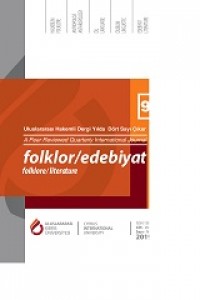Öz
This article examines the problems of temporality in narrative theory within the
specific frame of Chinese pictorial narratives in handscroll format. This particular
focus on handscrolls and on the Chinese tradition of representational painting—
as opposed to other media of production and other traditions of representational
art—is motivated by the privileged status of Chinese painting in art history, and the
invaluable insights offered by the handscroll format to the field of narrative theory.
Chinese painting constitutes one of the two oldest traditions of representational
painting in the world, along with the amply studied European tradition, and
it significantly differs from the European tradition due to the value it places on
deixis; while one of the goals of the European representational tradition has been to
perfect techniques that would erase all signs of the artist’s brushwork, so that a full
illusion of three-dimensional reality could be created on a two-dimensional surface,
Chinese representational painting has placed great import on the preservation of
the traces of the artist’s brushwork; so much so that an educated contemplation of
a representational Chinese painting invariably involves two subjects: the visibl subject, such as a landscape or a scene from daily life, and the subject of the artist’s
hand moving over the painting’s surface at the time of its creation. In paintings
rendered in the handscroll format, where viewers are allowed to experience
movement both in space and in time, parallel to their own movements of rolling
and unrolling the scroll, an array of problems concerning narrative time, memory,
and learning through story-building could be addressed effectively. Thus, through
an overview of the six principles of Chinese painting, followed by an analysis of
the variations in compositional method and the prevailing genres of handscroll
paintings, this article explores the intricacies of storytelling—through verbal or
pictorial means alike—not as a one-way communication, but rather as a neural
network where the meaning, that is, the experience of the story is continuously rebuilt
through multi-directional interactions with the artists and their work.
Anahtar Kelimeler
Kaynakça
- Abbott, P. H. (2002). The Cambridge introduction to narrative. Cambridge: Cambridge University.
- Benjamin, W. (1968). The storyteller: Reflections on the works of Nikolai Leskov.
- Illuminations. (Trans. H. Zohn ). New York: Harcourt, Brace & World, Inc.
- Bryson, N. (1983). Vision and painting: The logic of the gaze. London: The Macmillan Press.
- Bush, S., & Shih, H. (Eds.). (1985). Early Chinese texts on painting. Cambridge, MA, & London, UK: Harvard University.
- Chen, P. (1995). Time and space in Chinese narrative paintings of Han and the Six Dynasties.
- In C. Huang & E. Zürcher (Eds.), Time and space in Chinese culture (pp. 239-285). Leiden, New York & Köln: E. J. Brill.
- Cheng, F. (1994). Empty and full: The language of Chinese painting. (Trans. M. H. Kohn). Boston & London: Shambhala.
- Culler, J. (1980). Story and discourse in the analysis of narrative. In The pursuit of signs: Semiotics, literature, deconstruction. Ithaca, NY: Cornell University.
- Fong, W. C. (1992). Beyond representation: Chinese painting and calligraphy 8th – 14th century. New York: The Metropolitan Museum of Art.
- Hay, J. (1972, May). ‘Along the river during winter’s first snow’: A tenth-century handscroll and early Chinese narrative. The Burlington Magazine, 114(830), 294-303.
- Kreiswirth, M. (2000, Summer). Merely telling stories? Narrative and knowledge in the Human Sciences. Poetics Today, 21(2), 294-315.
- Lengyel, A. (2000, Spring). Three thousand years of Chinese painting. China Review International, 7(1), 260-269.
- Murray, J. K. (1989). Sung Kao-Tsung as artist and patron: The theme of dynastic revival. In C. Li, J. Cahill & W. Ho (Eds.), Artists and patrons: Some social and economic aspect of Chinese painting. Hong Kong: Don Bosco Printing.
- Rowley, G. (1959). Principles of Chinese painting. Princeton, NJ: Princeton University Press. Sirén, O. (1970). How the Chinese envisage the art of painting. In M. Courtois (Ed.), Chinese painting. (P. Eve, Trans.). London: Heron.
- Sullivan, M. (1979). Symbols of eternity: The art of landscape painting in China. Stanford, CA: Stanford University.
- Tekin, K. (2013, March). Images inside words: Framing the visual in Salman Rushdie’s The Moor’s Last Sigh. Wasafiri, 28(1), 68-74.
- Weitzmann, K. (1970). Illustrations in roll and codex: A study of the origin and method of text illustration. Princeton: Princeton University.
- Weng, W. (1978). Chinese painting and calligraphy: A pictorial survey. New York: Dover Publications. Yourcenar, M. (1975). Comment Wang-Fô fut sauvé. In Nouvelles orientales. Paris: Gallima
Ayrıntılar
| Birincil Dil | İngilizce |
|---|---|
| Konular | Antropoloji |
| Bölüm | Derleme Makaleleri -Compilation Articles |
| Yazarlar | |
| Yayımlanma Tarihi | 1 Ağustos 2019 |
| Yayımlandığı Sayı | Yıl 2019 Cilt: 25 Sayı: 99 |
Derginin yayım dili Türkçe ve İngilizce’dir, ayrıca Türkçe de olsa tüm basılan makalelerin başlık, öz ve anahtar sözcükleri İngilizce olarak da makalede bulunur. Hakemlerden onay almış Türkçe makaleler için 750-1000 sözcükten oluşan genişletilmiş özet (extended summary) gereklidir. Elektronik çeviriler kabul edilmez.
Dergi TR-Dizin, Web of Science (ESCI), DOAJ ile diğer pek çok dizin tarafından taranmaktadır. Scimagoe quartile değeri: Q2 'dir:
TR DIZIN 2020 Etik Kriterleri kapsamında, dergimize 2020 yılından itibaren etik kurul izni gerektiren çalışmalar için makalenin yöntem bölümünde ilgili Etik Kurul Onayı ile ilgili bilgilere (kurul-tarih-sayı) yer verilmesi gerekecektir. Bu nedenle dergimize makale gönderecek olan yazarlarımızın ilgili kriteri göz önünde bulundurarak makalelerini düzenlemeleri önemle rica olunur.
Alan Editörleri/ Field Editörs
Halkbilimi/Folklore
Prof.Dr. Hande Birkalan-Gedik (JohannWolfgang-Goethe İniversitet-birkalan-gedik@m.uni-frankfurt.de)
Prof.Dr. Ali Yakıcı (Gazi Üniversitesi-yakici@gazi.edu.tr)
Prof.Dr. Aynur Koçak (Yıldız Teknik Üniversitesi-nurkocak@yildiz.edu.tr)
Prof.Dr. Işıl Altun ( (Regensburg Üniversitesi/Kocaeli Üniversitesi-İsil.Altun@zsk.uni-regensburg.de)
Edebiyat/Literature
Prof.Dr. Abdullah Uçman (Mimar Sinan Güzel Sanatlar Üniversitesi -emekli-29 MayısÜniversitesi-abdullahucman@29mayis.edu.tr
Prof. Dr. Ramazan Korkmaz (Ardahan Üniversitesi-emekli-Kafkasya Üniversiteler Birliği -KÜNİB-r_korkmaz@hotmail.com)
Prof.Dr. Emel Kefeli (Marmara Üniversitesi-emekli-İstanbul 29 Mayıs Üniversitesi-ayseemelkefeli @gmail.com)
Antropoloji/Anthropology
Prof.Dr. Hanife Aliefendioğlu (Doğu Akdeniz Üniversitesi-hanife.aliefendioglu@emu.edu.tr)
Prof. Dr. Şebnem Pala Güzel (Başkent Üniversitesi-sebnempa@baskent.edu.tr)
Prof.Dr. Derya Atamtürk Duyar (İstanbul Üniversitesi-datamturk@istanbul.edu.tr)
Prof.Dr. Meryem Bulut (Ankara Üniversitesi-meryem.bulut@gmail.com)
Dil-Dilbilim/Language-Linguistics
Prof.Dr. Nurettin Demir (Hacettepe Üniversitesi-demir@hacettepe.edu.tr)
Prof. Dr. Aysu Erden (Maltepe Üniversitesi-aysuerden777@gmail.com)
Prof.Dr. Sema Aslan Demir (Hacettepe Üniversitesi-semaaslan@hacettepe.edu.tr)


